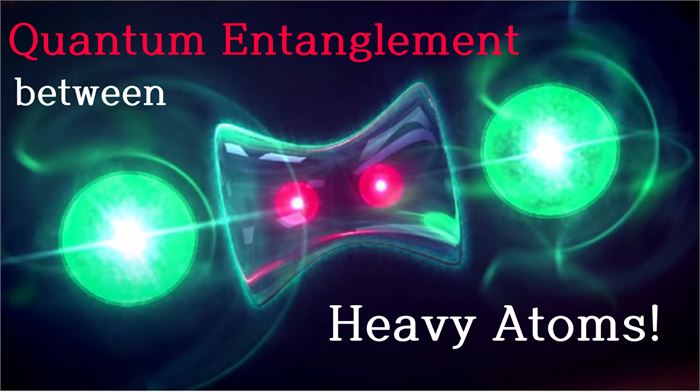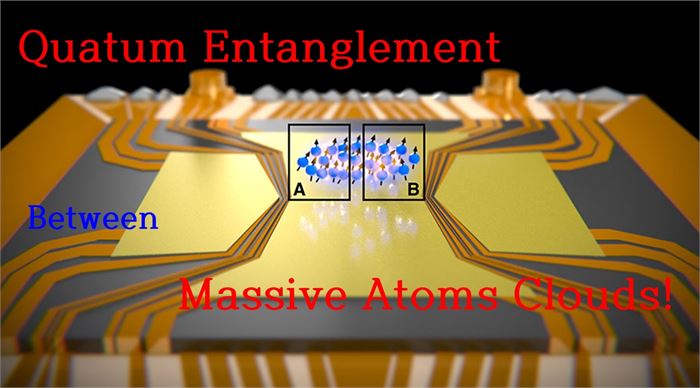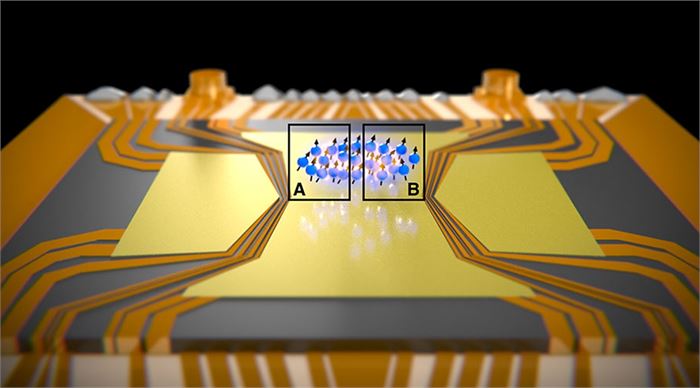 Still from an animation of a NIST quantum entanglement experiment conducted in 2013. (Yiheng Lin/NIST/YouTube)
Still from an animation of a NIST quantum entanglement experiment conducted in 2013. (Yiheng Lin/NIST/YouTube)
양자 얽힘, 무거운 원자들도 가능하다!
Q1. 앞의 2개 비디오에서 우리는 ‘양자 얽힘’을 확인한 아스페 팀의 실험과 얽힌 광자 실험으로 2022년 노벨물리학상을 수상한 수상자들의 연구업적을 살펴보았다. 이들의 실험은 모두 질량이 0인 광자를 사용해 얽힘을 확인한 것이었다. 그렇다면, ‘양자 얽힘’은 질량이 0이 아니라 무거운 원자들에서도 가능한가?
Q2. 가능하다. 이를 확인한 연구결과가 있다.
최근 스위스 바젤대학의 물리학자 Paolo Colciaghi, Yifan Li 팀과 Philipp Treutlein, Tilman Zibold 팀은 각각 700개의 루비듐-87 원자로 구성된 원자구름에서 양자 얽힘 현상을 확인했다. 이 연구는 물리학 저널 Physical Review X에 게재되었다.
Q3. 와우, 아인슈타인이 '말도 안 된다'는 뜻으로 ‘유령 같은 원격작용(spooky action at a distance!)’이라고 소리친 ‘양자 얽힘(quantum entanglement)’ 현상이 광자가 아닌 무거운 원자 덩어리(massive atoms system)에서도 확인됐다니 놀랍다. 무거운 원자들의 양자 얽힘 실험으로 이게 처음인가 아니면 또 다른 연구결과가 있는가?
이보다 앞선 또다른 연구결과가 보고되었다. 세계적인 과학학술지 사이언스(Science)는 2018년 4월 이와 관련된 논문 3편을 나란히 실었다. 이들 논문은 앞의 연구팀이 소속된 스위스 바젤대학과 독일 하노버대학, 그리고 독일 하이델베르크대학 연구팀의 논문이다.
Q4. 그동안 우리는 아스페 팀의 실험 이후로 ‘양자 얽힘’ 현상을 의심하지 않을 정도로 많이 확인했다. 심지어 중국의 연구팀은 양자 얽힘을 이용해 7600㎞에 이르는 장거리 양자통신 실험에 성공했다는 소식을 우리는 들었다. 하지만 이들 실험은 모두 질량이 없는 광자(photon)를 이용한 것이었다. 이들 원자 덩어리를 통한 양자 얽힘 실험의 개요를 설명해달라.
이들 실험의 개념은 공교롭게도 비슷하다. 이들 모두 공간적으로 분리된 ‘극저온 원자 구름(clouds of ultracold atoms) 사이의 얽힘 현상을 독립적으로 확인한 것이다.
연구팀은 모두 질량이 제로(0)인 광자 대신 비교적 무거운 원소인 루비듐(원자번호 37, 원자량 85.48)을 사용했다. 바젤대학 연구팀은 700개의 루비듐 원자를 절대온도 0도에 가깝게 냉각해 ‘보즈-아인슈타인 응축(Bose-Einstein condensate, BEC)’ 상태로 만들어 다원자의 얽힘 실험을 시작했다.
BEC 상태는 일종의 냉각된 원자 구름으로, 모든 원자들은 동일한 성질을 갖는 입자들처럼 행동하고, 따라서 동일한 양자 상태를 갖는다. 연구팀은 보즈-아인슈타인 응축 상태를 만든 다음 입자 사이의 상호작용을 유도하여 각 원자의 스핀 상태를 얽히게 만든다.
그 다음, 원자를 가둔 트랩을 느슨하게 이완하면 원자 구름이 퍼져나가고, 결국 두 개의 작은 구름(A, B)으로 나뉘어진다.
Q5. 자, 이제 이렇게 분리된 A 원자들의 스핀과 B 원자들의 ‘얽힌 스핀’이 보존되는지 아니면 깨지는지를 확인해봐야 할텐데, 연구팀은 이를 어떻게 확인했나?
이를 확인하기 위해 연구팀은 고주파를 사용하여 입자를 조작함으로써 각 구름에서 입자의 특정 스핀 상태를 관측했다. 얽힘이 보존된다면, 구름 A 안의 입자의 스핀 상태는 구름 B 안의 입자의 스핀 상태와 높은 관련성을 보여야 한다. 이는 한쪽의 스핀 상태를 관찰하면 다른 쪽의 스핀 상태가 즉각 결정되고, 그 반대의 경우도 마찬가지이기 때문이다. 연구팀은 정확하게 이 현상을 발견했다. 연구팀은 얽힘을 통해 얽힌 시스템의 한 부분에 대한 측정으로 다른 부분을 특정 상태로 '조종(steer)' 하는 ‘양자 조향(quantum steering)’이 가능함을 확인했다.
 전자기장에 의해 마이크로 칩 위에 붙들려 있는 원자 구름 개념도. 공간적으로 분리된 영역 A와 B 사이에서 얽힘 현상이 관찰되었다. 출처 : 스위스 바젤대학 물리학과
전자기장에 의해 마이크로 칩 위에 붙들려 있는 원자 구름 개념도. 공간적으로 분리된 영역 A와 B 사이에서 얽힘 현상이 관찰되었다. 출처 : 스위스 바젤대학 물리학과
Q6. 양자 얽힘이 광자만의 특성이 아니라 질량을 가진 물질에도 성립한다면 그야말로 ‘우주는 공간적으로 얽혀 있다’고 말할 수 있게 되겠다. 이들 연구의 의미는 무엇인가?.
이들 연구는 양자 얽힘의 새로운 문을 열었다고 평가된다. 즉, 질량이 큰 거시세계 물질 간의 양자 얽힘 탐구의 방아쇠가 될 게 분명하다.
Q7. 이들 연구는 어느 분야에 응용될 수 있을까?
양자 얽힘은 양자컴퓨팅, 양자통신 등 차세대 양자기술의 획기적인 발전에도 기여할 것으로 기대를 모은다. 특히 이번 연구는 ‘광자 얽힘’보다 더 많은 입자들의 얽힘을 이용함으로써 머지않아 양자 컴퓨팅과 양자 통신 그리고 초정밀 측정의 과학인 계측학(metrology) 분야에 응용될 전망이다.
Quantum entanglement holds for even massive atoms clouds!
Q1. In the previous two videos, we looked at the Aspect team's experiment that confirmed 'quantum entanglement' and the research achievements of the 2022 Nobel Prize in Physics winners for their entangled photon experiments. All of their experiments confirmed entanglement using zero-mass photons. Then, is ‘quantum entanglement’ possible even in atoms with non-zero mass?
Q2. possible. There are research results that confirm this.
Still from an animation of a NIST quantum entanglement experiment
Recently, a research team from the Department of Physics at the University of Basel in Switzerland (Paolo Colciaghi, Yifan Li, Philipp Treutlein, Tilman Zibold) has shown the quantum entanglement phenomenon in clouds composed of 700 rubidium-87 atoms. The study was published in the physics journal Physical Review X.
Q3. Wow, the 'quantum entanglement' that Einstein called 'spooky action at a distance!'
It is surprising that the entanglement was confirmed not only in photons but also in the massive atoms system. Is this the first experiment of quantum entanglement of massive atoms or is there another research result?
Another study was reported earlier than this. In April 2018, Science, a world-renowned scientific journal, published three papers on quantum entanglement of massive atoms side by side.
These papers are thesis of the research team of the University of Basel, Switzerland, the University of Hanover, Germany, and the University of Heidelberg, Germany.
Q4. In the meantime, since the Aspect team's experiment, we have known the phenomenon of 'quantum entanglement' so much that we do not doubt it. We even heard that a Chinese research team succeeded in experimenting with long-distance quantum communication up to 7,600km using quantum entanglement. However, all of these experiments used massless photons. Explain the outline of quantum entanglement experiments with these clouds of atoms.
The concepts of these experiments are coincidentally similar. All of these are independent confirmations of entanglement between spatially separated “clouds of ultracold atoms.”
The research team used a relatively heavy element, rubidium-87, instead of the zero-mass photon. The research team at the University of Basel cooled 700 rubidium atoms to a temperature close to absolute zero and made them into a “Bose-Einstein condensate (BEC)” state to begin experiments with polyatomic entanglement.
The BEC state is a kind of cooled atoms cloud, in which all atoms behave like particles with the same properties and therefore have the same quantum state. The research team creates a Bose-Einstein condensed state and then entangles the spin state of each atom by inducing interactions between the particles.
Then, when the traps confining the atoms are loosened, the cloud of atoms spreads out, eventually splitting into two smaller clouds (A and B).
Q5. Now, we need to check whether the spins of the separated A atoms and the ‘entangled spins’ of the B atoms are conserved or broken. How did the research team show this?
To show this, the research team observed the specific spin state of the particles in each cloud by manipulating them using high-frequency waves. If entanglement is conserved, the spin state of the particle in cloud A should show a high correlation with the spin state of the particle in cloud B. This is because observing the spin state on one side immediately determines the spin state on the other side, and vice versa. The research team discovered exactly this phenomenon. Through entanglement, the research team confirmed that measurement of one part of the entangled system makes it possible to 'steer' another part to a specific state, called 'quantum steering'.
 A cloud of atoms is held above a chip by electromagnetic fields. The Entanglement was observed between the spatially separated regions A and B (Illustration: University of Basel, Department of Physics)
A cloud of atoms is held above a chip by electromagnetic fields. The Entanglement was observed between the spatially separated regions A and B (Illustration: University of Basel, Department of Physics)
Q6. If quantum entanglement is not only a characteristic of photons, but also applies to materials with mass, it will be possible to say that the universe is spatially entangled. What are the implications of these studies?
These studies are evaluated as opening a new door to quantum entanglement. In other words, it is sure to be a trigger for exploring quantum entanglement between massive macroscopic materials.
Q7. Where can these studies be applied?
Quantum entanglement is expected to contribute to the breakthrough of next-generation quantum technologies such as quantum computing and quantum communication. In particular, this research is expected to be applied to metrology, a science of ultra-precision measurement, as well as quantum computing and quantum communication in the near future by using entanglement of more particles than photon entanglement.
<pinepines@injurytime.kr>